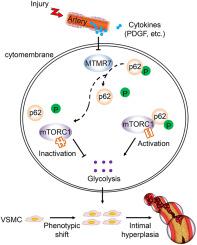当前位置:
X-MOL 学术
›
Atherosclerosis
›
论文详情
Our official English website, www.x-mol.net, welcomes your feedback! (Note: you will need to create a separate account there.)
MTMR7 suppresses the phenotypic switching of vascular smooth muscle cell and vascular intimal hyperplasia after injury via regulating p62/mTORC1-mediated glucose metabolism
Atherosclerosis ( IF 5.3 ) Pub Date : 2024-02-01 , DOI: 10.1016/j.atherosclerosis.2024.117470 Xiongshan Sun , Yao Yang , Weiwei Zhao , Mingliang Wang , Yingmei Chen , Jia Wang , Dachun Yang , Yongjian Yang
Atherosclerosis ( IF 5.3 ) Pub Date : 2024-02-01 , DOI: 10.1016/j.atherosclerosis.2024.117470 Xiongshan Sun , Yao Yang , Weiwei Zhao , Mingliang Wang , Yingmei Chen , Jia Wang , Dachun Yang , Yongjian Yang

|
Myotubularin-related protein 7 (MTMR7) suppresses proliferation in various cell types and is associated with cardiovascular and cerebrovascular diseases. However, whether MTMR7 regulates vascular smooth muscle cell (VSMC) and vascular intimal hyperplasia remains unclear. We explored the role of MTMR7 in phenotypic switching of VSMC and vascular intimal hyperplasia after injury. MTMR7 expression was significantly downregulated in injured arteries. Compared to wild type (WT) mice, -transgenic (-Tg) mice showed reduced intima/media ratio, decreased percentage of Ki-67-positive cells within neointima, and increased Calponin expression in injured artery. upregulating MTMR7 by Len- transfection inhibited platelet derived growth factor (PDGF)-BB-induced proliferation, migration of VSMC and reversed PDGF-BB-induced decrease in expression of Calponin and SM-MHC. Microarray, single cell sequence, and other bioinformatics analysis revealed that MTMR7 is highly related to glucose metabolism and mammalian target of rapamycin complex 1 (mTORC1). Further experiments confirmed that MTMR7 markedly repressed glycolysis and mTORC1 activity in PDGF-BB-challenged VSMC . Restoring mTORC1 activity abolished MTMR7-mediated suppression of glycolysis, phenotypic shift in VSMC and protection against vascular intimal hyperplasia . Furthermore, upregulating MTMR7 led to dephosphorylation and dissociation of p62 from mTORC1 in VSMC. External expression of p62 also abrogated the inhibitory effects of MTMR7 on glycolysis and phenotypic switching in PDGF-BB-stimulated VSMC. Our study demonstrates that MTMR7 inhibits injury-induced vascular intimal hyperplasia and phenotypic switching of VSMC. Mechanistically, the beneficial effects of MTMR7 are conducted via suppressing p62/mTORC1-mediated glycolysis.
中文翻译:

MTMR7通过调节p62/mTORC1介导的葡萄糖代谢抑制损伤后血管平滑肌细胞表型转换和血管内膜增生
肌管蛋白相关蛋白 7 (MTMR7) 可抑制多种细胞类型的增殖,并与心脑血管疾病相关。然而,MTMR7是否调节血管平滑肌细胞(VSMC)和血管内膜增生仍不清楚。我们探讨了 MTMR7 在损伤后 VSMC 表型转换和血管内膜增生中的作用。受损动脉中 MTMR7 表达显着下调。与野生型(WT)小鼠相比,-转基因(-Tg)小鼠表现出内膜/中膜比率降低、新内膜内Ki-67阳性细胞百分比降低以及受损动脉中钙调蛋白表达增加。通过Len转染上调MTMR7可抑制血小板源性生长因子(PDGF)-BB诱导的增殖、VSMC迁移,并逆转PDGF-BB诱导的钙调蛋白和SM-MHC表达下降。微阵列、单细胞序列和其他生物信息学分析表明,MTMR7与葡萄糖代谢和哺乳动物雷帕霉素靶点复合物1(mTORC1)高度相关。进一步的实验证实,MTMR7 显着抑制 PDGF-BB 攻击的 VSMC 中的糖酵解和 mTORC1 活性。恢复 mTORC1 活性可以消除 MTMR7 介导的糖酵解抑制、VSMC 表型转变和血管内膜增生保护。此外,上调 MTMR7 导致 VSMC 中 p62 去磷酸化和从 mTORC1 解离。p62 的外部表达还消除了 MTMR7 对 PDGF-BB 刺激的 VSMC 中糖酵解和表型转换的抑制作用。我们的研究表明,MTMR7 抑制损伤引起的血管内膜增生和 VSMC 表型转换。从机制上讲,MTMR7 的有益作用是通过抑制 p62/mTORC1 介导的糖酵解来实现的。
更新日期:2024-02-01
中文翻译:

MTMR7通过调节p62/mTORC1介导的葡萄糖代谢抑制损伤后血管平滑肌细胞表型转换和血管内膜增生
肌管蛋白相关蛋白 7 (MTMR7) 可抑制多种细胞类型的增殖,并与心脑血管疾病相关。然而,MTMR7是否调节血管平滑肌细胞(VSMC)和血管内膜增生仍不清楚。我们探讨了 MTMR7 在损伤后 VSMC 表型转换和血管内膜增生中的作用。受损动脉中 MTMR7 表达显着下调。与野生型(WT)小鼠相比,-转基因(-Tg)小鼠表现出内膜/中膜比率降低、新内膜内Ki-67阳性细胞百分比降低以及受损动脉中钙调蛋白表达增加。通过Len转染上调MTMR7可抑制血小板源性生长因子(PDGF)-BB诱导的增殖、VSMC迁移,并逆转PDGF-BB诱导的钙调蛋白和SM-MHC表达下降。微阵列、单细胞序列和其他生物信息学分析表明,MTMR7与葡萄糖代谢和哺乳动物雷帕霉素靶点复合物1(mTORC1)高度相关。进一步的实验证实,MTMR7 显着抑制 PDGF-BB 攻击的 VSMC 中的糖酵解和 mTORC1 活性。恢复 mTORC1 活性可以消除 MTMR7 介导的糖酵解抑制、VSMC 表型转变和血管内膜增生保护。此外,上调 MTMR7 导致 VSMC 中 p62 去磷酸化和从 mTORC1 解离。p62 的外部表达还消除了 MTMR7 对 PDGF-BB 刺激的 VSMC 中糖酵解和表型转换的抑制作用。我们的研究表明,MTMR7 抑制损伤引起的血管内膜增生和 VSMC 表型转换。从机制上讲,MTMR7 的有益作用是通过抑制 p62/mTORC1 介导的糖酵解来实现的。



























 京公网安备 11010802027423号
京公网安备 11010802027423号